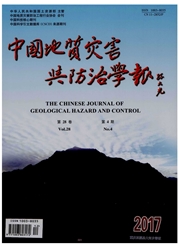

 中文摘要:
中文摘要:
本文总结了汶川地震灾区泥石流物源的主要类型,即:滑坡堵沟型物源、崩塌覆盖型物源、碎屑坡积型物源。根据三类物源参与泥石流活动的特点,建立了泥石流动储量的启动地质模式,沟谷下切侵蚀堵溃式和沟谷侧缘侵蚀滑坍式。在此基础上,选择地震灾区44处泥石流为样本,采用数学统计方法获得了总物源量与动储量的相关性,基本呈线性关系。总物源量为50×104m3以内时,动储量可达到15%;总物源量为100×104m3以内时,动储量可达到30%;总物源量为200×104m3以内时,动储量可达到37%;总物源量超过300×104m3时,动储量可超过40%。根据动储量的启动地质模式,本文还提供了计算单体动储量的图解法。
 英文摘要:
英文摘要:
The geological model of the dynamic reserve of debris flow material source including downward induced block collapse and lateral erosion induced slide and sloughing was established on the basis of the classification of the debris flow material source which come from landslide, rock falls and deposits on the slopes. 44 debris flows in Wenchuan earthquake region were selected to analyze the correlation of the dynamic reserve and the total amount of the debris flow material source, which was proposed as the linear relationship, according to the statistics of the analysis, the dynamic reserves is up to 15% , 30% , 37% and 40% when the total amount of material source is less than 50× 104m^3 , 100 × 104m^3 , 200 × 104m^3 and 300 × 104 m^3. The graphic calculate method for confirming the dynamic reserve was proposed according to the geological model of the failure of the debris flow material source.
 同期刊论文项目
同期刊论文项目
 同项目期刊论文
同项目期刊论文
 期刊信息
期刊信息
